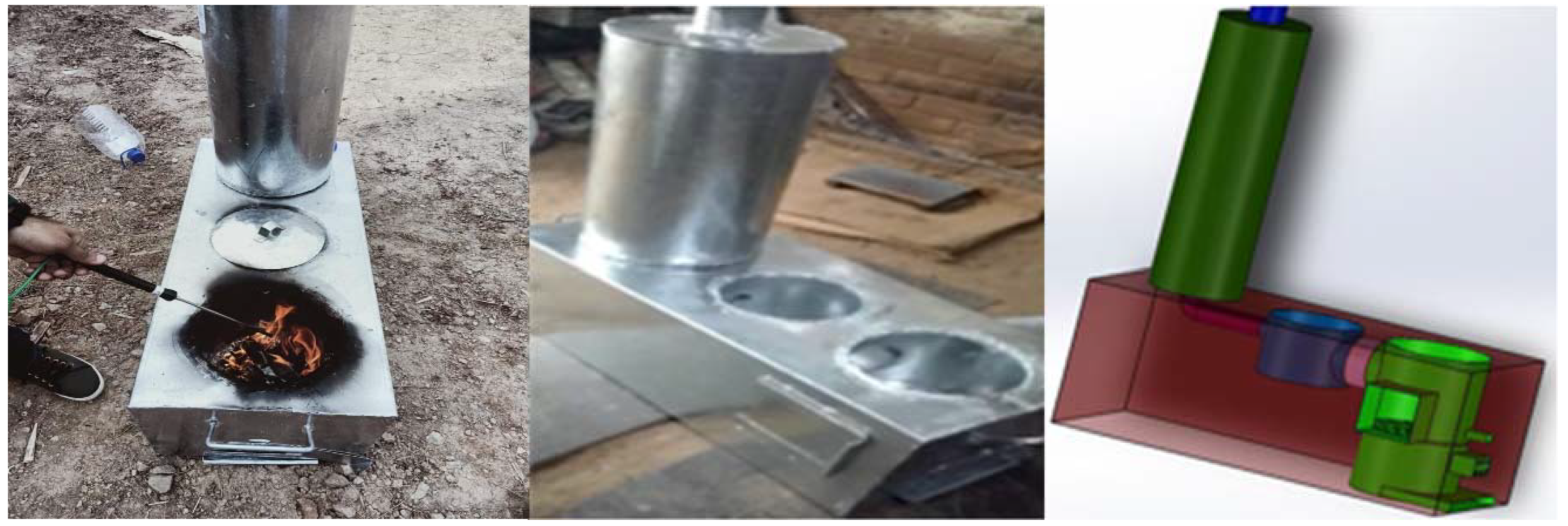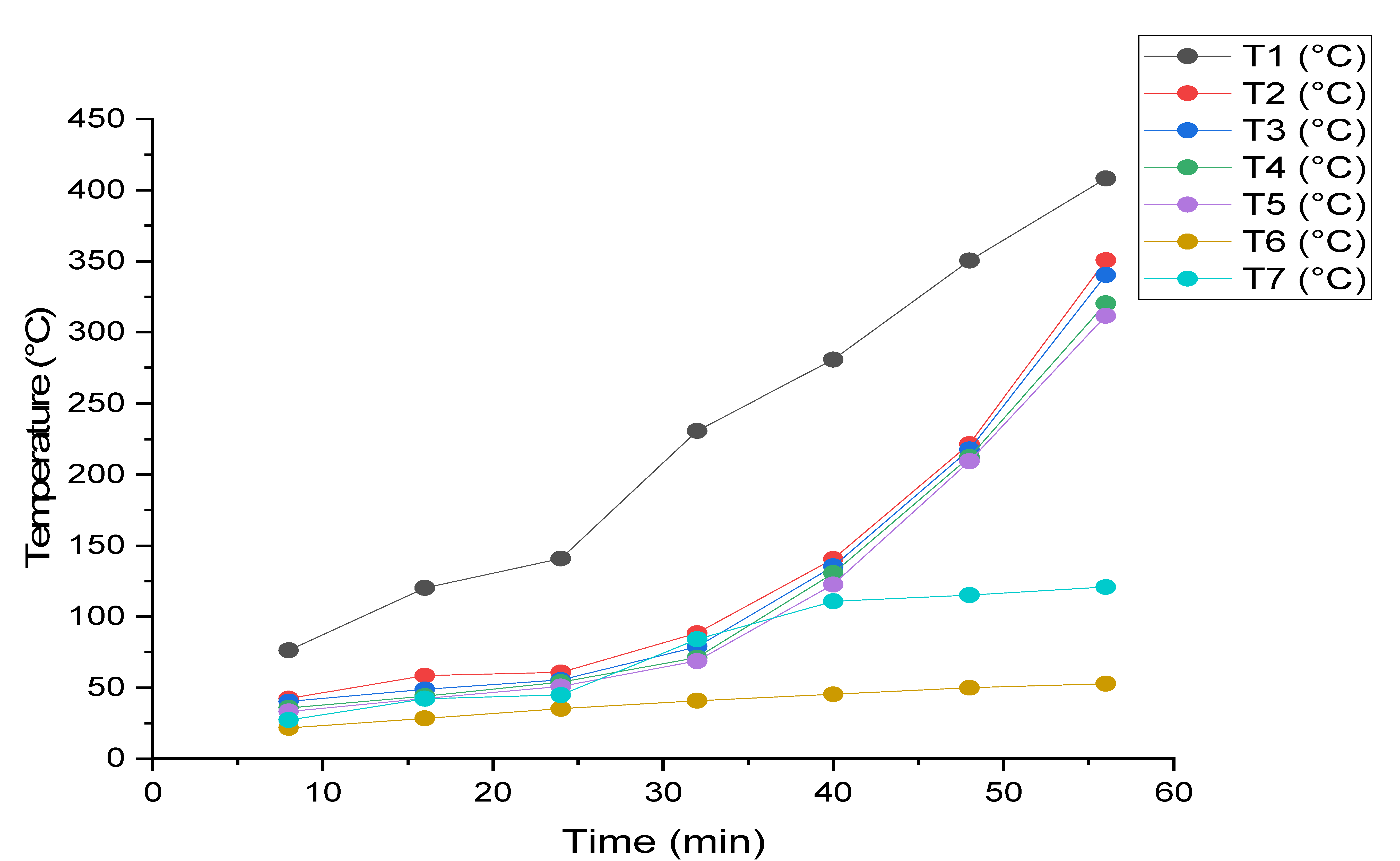1. Introduction
Energy proves itself essential in multiple ways for the human development cycle, from food processing to living style, communication to travelling, and basic necessities to modern provisions, etc. Therefore, an energy deficit entails serious effects for elementary human necessities, i.e., space heating, food preparation and lighting [
1]. It becomes a vital need to find sources that are renewable energy-based so that energy requirements can be met at all levels of consumption. There is no doubt that biomass has consistently been a crucial source of energy for mankind since time immemorial [
2]. Consequently, the trajectory of a country’s economic development can be partially traced by analyzing the trend of its energy usage [
3].
About three billion individuals around the world make food by using traditional cook stoves which depend upon fuels such as firewood, crop residue, dung cakes and charcoal, which cause greenhouse gas emissions, indoor air quality damage and health issues [
4]. Burning of solid fuels results in vulnerability to health hazards in poor rural people, especially women and children [
5]. Appropriate designs of biomass stoves are needed for the use of biofuels in a thermal conversion mode. Compared with improved cook stoves, standard biomass cook stoves have poor thermal performance and high fuel gas emissions [
6]. Globally, large-scale attempts have been made not only to reduce the risks presented by inefficient biofuel use to the well-being of people and their surroundings, but also to disseminate fuel-saving and energy-efficient stoves known as improved cook stoves [
7]. ICS with dramatically lower emissions help reduce household air pollution and effectively minimize time, expense and air pollution-related diseases. Particulate matter and CO
2 emissions [
8] can be minimized to the range of 10–15 ppm and 0.9–1.3 ppm respectively by the use of ICS. ICS with single and double mouths have a thermal efficiency of 35% and 22.88%, respectively. Performance results show that the emission of CO and CO
2 is within the admissible limit as recommended by the World Health Organization [
9].
This study aims to develop and produce an ICS model for the northern areas of Pakistan, such as Gilgit-Baltistan, with a better design and proper ventilation system. Since its combustion chamber is closed, this model performs better than a traditional biomass cook stove. This encourages the combustion products to reach a higher temperature, enabling fuel to be burned more efficiently. In addition, to help to preserve and circulate hazardous biomass emissions, the outer body and combustion chamber are separated by gaps, thus enhancing the likeliness of a complete reaction. However most notably, an exhaust pipe is connected to the model, which almost completely removes air emissions from indoor households.
2. Methodology
The detailed design procedure, construction and key features of the improved cook stove are explained in this section.
Model Design
An energy-efficient double mouth ICS prototype with chimney was constructed using SOLIDWORKS software to meet the energy requirements of a family of 4–6 people. Schematic diagrams of the biomass-driven ICS from various angles of view are shown in
Figure 1. Primary and secondary cook stoves and exhaust pipes were well insulated to minimize heat loss to the surroundings. A baffle was also provided for controlling the secondary air intake. The primary exhaust pipe had a larger diameter in order to maximize the escape of flue gases to the secondary stove. An insulated hot water tank was placed around the chimney on the top of the ICS body.
Natural draft flow moved the air through the inlet and upwards to the grate plate, and after the complete combustion process, flue gases escaped from the primary exhaust pipe to the secondary stove and then via the exhaust to the chimney. An emergency air inlet was also placed just above the grate plate with the purpose of providing air to the combustion chamber if the primary air inlet stops due to ash blocking the holes of the grate plate. The purpose of this prototype model was to extract the maximum heat generated by the burning fuel and to achieve a cleaner environment around the cooking place by burning the fuel completely at high temperatures, thereby saving the cost of fuel, obtaining more thermal efficiency and reducing real fuel consumption. The ICS was primarily designed for wood sticks, however, there is a provision for burning other types of fuels such as wood cubes, corn cobs, coconut shells, saw dust, rice husk, coal, coal briquettes, biomass briquettes, etc. It can be placed at an appropriate location anywhere. The height and length of the chimney can be adjusted. Pots of various diameters ranging between 7 and 13 inches can be used. The proposed ICS is shown in
Figure 1.
3. Experimentation
3.1. Experimental Setup
The experiment was performed on the prototype to check the feasibility and workings of the model. In order to perform the test, 1 kg of pure dry wood was taken and burned in the primary stove at normal temperature and pressure. The experiment was performed in the open air, and temperatures were recorded at intervals of 8 min, for 56 min, at specified locations across the ICS. Seven thermocouples (T1 = flame temperature in primary stove (flame), T2 = primary stove body temperature (body), T3 = primary exhaust pipe temperature (smoke), T4 = secondary stove body temperature (body), T5 = secondary exhaust pipe temperature (smoke), T6 = water temperature in tank (water), T7 = exhaust exit temperature in chimney (smoke)) were used while recording this experiment.
3.2. Thermal Analysis
Thermal analysis results of the design model of the improved cooking stove (ICS) were extracted using ANSYS simulation. Computational domain and physics were attained by using heat transfer simulations and temperature distribution across the ICS body. Four different cases were simulated using the same model. Initially the boundary conditions were used from the test results of the fabricated model of the designed ICS. There were four types of boundary conditions used for the simulations while achieving a practical interaction with the cooking stove problem: Case 1 (100 W/m
2 °C), Case 2 (50 W/m
2 °C), Case 3 (20 W/m
2 °C), Case 4 (20 W/m
2 °C); water temperature was derived from the thermal analysis of the ICS model. All analyses were conducted at steady state, 22 °C ambient temperature, and 350 °C temperature at main stove, while changing the convective heat transfer coefficient in the case studies. All simulation results are shown graphically in
Figure 2a–d.
Experimental results are shown in
Figure 3. It can be observed that the maximum combustion temperature of the main stove reached 408.2 °C, which is sufficient to prepare any kind of food, and the minimum temperature of the smoke at the outlet of the chimney was 120.8 °C. The difference in the temperature clearly shows that thermal energy was gained by the water that surrounded the chimney. To further validate the experimental results, thermal analysis results showed the variation in temperature across the stove body. A different convective heat coefficient helped in achieving a common trend, that the maximum temperature only radiated around the center of the main stove and a minimum temperature of around 22–52 °C was achieved on the outer body of the stove. In Cases 1, 2, and 3, only convective heat transfer coefficient was changed, but in Case 4 the water temperature was derived from the outlet temperature of the exhaust which showed that a temperature of around 180 °C was available at the bottom of the water tank, which was comparatively higher than the other cases. Therefore, this will help in heating the water more efficiently and will increase the thermal efficiency of the ICS.
4. Conclusions
Over the last three decades, a number of ICS models have been developed in South Asia. It is a fact that due to a low per capita income, a huge number of people cannot afford to cook with cleaner commercial fuel. To address this problem, the current study proposes a new type of improved cooking stove (ICS) for cold rural populations, which helps in the complete combustion of biomass fuels, to increase fuel savings and minimize hazardous gas emissions. The performance evaluation tests and numerical analyses shows ICS to be the best option and viable to be implemented.









